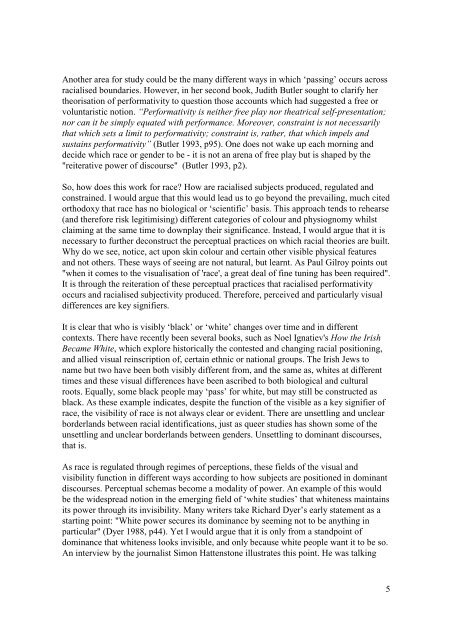1 'Troubling race. Using Judith Butler's work to think about racialised ...
1 'Troubling race. Using Judith Butler's work to think about racialised ...
1 'Troubling race. Using Judith Butler's work to think about racialised ...
You also want an ePaper? Increase the reach of your titles
YUMPU automatically turns print PDFs into web optimized ePapers that Google loves.
Another area for study could be the many different ways in which ‘passing’ occurs across<br />
<strong>racialised</strong> boundaries. However, in her second book, <strong>Judith</strong> Butler sought <strong>to</strong> clarify her<br />
theorisation of performativity <strong>to</strong> question those accounts which had suggested a free or<br />
voluntaristic notion. “Performativity is neither free play nor theatrical self-presentation;<br />
nor can it be simply equated with performance. Moreover, constraint is not necessarily<br />
that which sets a limit <strong>to</strong> performativity; constraint is, rather, that which impels and<br />
sustains performativity” (Butler 1993, p95). One does not wake up each morning and<br />
decide which <strong>race</strong> or gender <strong>to</strong> be - it is not an arena of free play but is shaped by the<br />
"reiterative power of discourse" (Butler 1993, p2).<br />
So, how does this <strong>work</strong> for <strong>race</strong>? How are <strong>racialised</strong> subjects produced, regulated and<br />
constrained. I would argue that this would lead us <strong>to</strong> go beyond the prevailing, much cited<br />
orthodoxy that <strong>race</strong> has no biological or ‘scientific’ basis. This approach tends <strong>to</strong> rehearse<br />
(and therefore risk legitimising) different categories of colour and physiognomy whilst<br />
claiming at the same time <strong>to</strong> downplay their significance. Instead, I would argue that it is<br />
necessary <strong>to</strong> further deconstruct the perceptual practices on which racial theories are built.<br />
Why do we see, notice, act upon skin colour and certain other visible physical features<br />
and not others. These ways of seeing are not natural, but learnt. As Paul Gilroy points out<br />
"when it comes <strong>to</strong> the visualisation of '<strong>race</strong>', a great deal of fine tuning has been required".<br />
It is through the reiteration of these perceptual practices that <strong>racialised</strong> performativity<br />
occurs and <strong>racialised</strong> subjectivity produced. Therefore, perceived and particularly visual<br />
differences are key signifiers.<br />
It is clear that who is visibly ‘black’ or ‘white’ changes over time and in different<br />
contexts. There have recently been several books, such as Noel Ignatiev's How the Irish<br />
Became White, which explore his<strong>to</strong>rically the contested and changing racial positioning,<br />
and allied visual reinscription of, certain ethnic or national groups. The Irish Jews <strong>to</strong><br />
name but two have been both visibly different from, and the same as, whites at different<br />
times and these visual differences have been ascribed <strong>to</strong> both biological and cultural<br />
roots. Equally, some black people may ‘pass’ for white, but may still be constructed as<br />
black. As these example indicates, despite the function of the visible as a key signifier of<br />
<strong>race</strong>, the visibility of <strong>race</strong> is not always clear or evident. There are unsettling and unclear<br />
borderlands between racial identifications, just as queer studies has shown some of the<br />
unsettling and unclear borderlands between genders. Unsettling <strong>to</strong> dominant discourses,<br />
that is.<br />
As <strong>race</strong> is regulated through regimes of perceptions, these fields of the visual and<br />
visibility function in different ways according <strong>to</strong> how subjects are positioned in dominant<br />
discourses. Perceptual schemas become a modality of power. An example of this would<br />
be the widespread notion in the emerging field of ‘white studies’ that whiteness maintains<br />
its power through its invisibility. Many writers take Richard Dyer’s early statement as a<br />
starting point: "White power secures its dominance by seeming not <strong>to</strong> be anything in<br />
particular" (Dyer 1988, p44). Yet I would argue that it is only from a standpoint of<br />
dominance that whiteness looks invisible, and only because white people want it <strong>to</strong> be so.<br />
An interview by the journalist Simon Hattens<strong>to</strong>ne illustrates this point. He was talking<br />
5

















